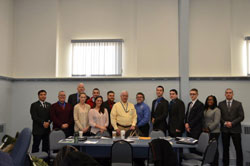On Jan. 21 st, 2016, Dr. John Comiskey and 11 Monmouth University students attended an exercise conducted by Federal Emergency Management Agency Region II. This workshop covered an increasingly important topic called Continuity of Operations. The event, known as the Hurricane Ed Continuity Tabletop Exercise, was held at the Freehold Regional High School District Office. This facility is located on 11 Pine Street in Englishtown, New Jersey. Dr. Comiskey provided a detailed description of the event:
“FEMA Region II, the New Jersey Department of Education, and faculty from Monmouth University’s Department of Criminal Justice have been working on State-wide plans to prepare New Jersey’s schools for disasters such as Superstorm Sandy that devastated parts of the State and region. Due to Superstorm Sandy’s impact on Monmouth County, principals and other school officials from the County were invited to participate in a pilot Continuity of Operations Plan (COOP) workshop that would orient the officials to COOP and other processes that are designed to mitigate disaster damage and help schools return to normal operations. Monmouth University’s homeland security students were asked to participate in the workshop. The workshop afforded the students to the opportunity to work with FEMA and Monmouth County education and emergency management officials. Currently, the workshop’s outcomes are being assessed to facilitate future School COOP workshops in each County in the State. Stay tuned for updates.”
The exercise gave Monmouth University’s students the opportunity to interact with New Jersey State Police, Office of Emergency Management, Transit, and Education officials. Individuals from every level of Monmouth’s student body gathered to record the conference. Notes were compiled into a series of after-action reports. This allowed the students to analyze their findings with an understanding developed at Monmouth University.
Monmouth University’s students also provided insight on the workshop. Mr. Sean Foley said “our knowledge from the classroom was tested in a real-world environment, working with school officials at the local and state levels.” Mr. Christopher Lambiase added that, “the exercise helped [him] apply what [he] learned in [his] own town,” showing the program to be “successful and beneficial.” Finally, Ms. Regina Strugala stated the importance of continuity planning, believing “towns and residents need to be prepared by having backup plans because one never knows when those plans will be needed.”
To prevent a scenario similar to Superstorm Sandy and Hurricane Katrina, the various professionals gathered into groups to counter “what-if” threats. The exercise began as Hurricane Ed, a hypothetical storm, was looming twenty-four hours from the Mid-Atlantic region of the United States, which includes New Jersey. The scenario put each organization’s response capabilities to the test. Participants had to react quickly to ensure schools remained functional.
Following this, Hurricane Ed makes landfall as a category four hurricane, severely damaging the impact area. Technological infrastructure and schools are heavily affected. Each group was faced with flooding, power loss, and disabled telephone systems. The threats have the potential to truly occur, making preparation a must. The final module handled the recovery phase. At this point, the fictional storm has left local facilities in ruin. Community members begin taking shelter in various locations, including schools. This presents a unique challenge to educators. In the event that a school should be disabled, administrators will need to switch to a secondary location as per their continuity plan. This alternative site should allow school activities to continue relatively unhindered. However, a problem arises with the idea of transporting students to this new facility. One solution can be found in the use of buses, which allow large portions of the student body to move quickly. Obtaining these resources requires total collaboration between schools, emergency responders, and the rest of the local community.
The after-action reports cited numerous strategies to help counteract disastrous weather. These observations apply to all organizations, even Monmouth University. Activities such as checking generators, fueling vehicles, securing outdoor objects, and clearing storm drains can be done prior to a storm. Developing a rapid response team comprised of qualified emergency management personnel can also help mitigate damage. Communicating with staff and students well ahead of time gives the populace a chance to react appropriately. Keeping and backing up records helps prevent data loss and confusion. Finally, a long-term plan must be developed before an emergency. Plans should be tested, exercised, and documented to ensure currency and effectiveness. Overall, continuity planning is time-worthy and critical to ensuring student and staff safety.
PHOTO COURTESY of Conor Scott



